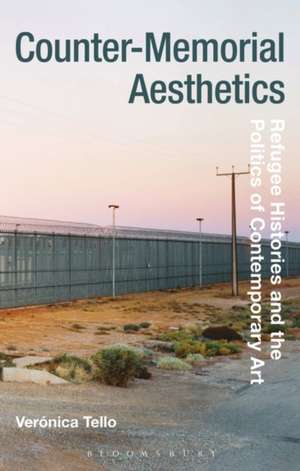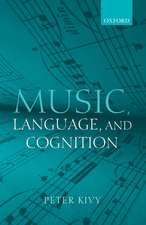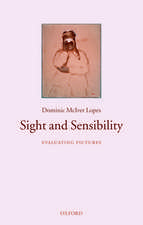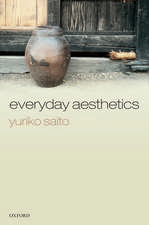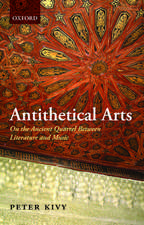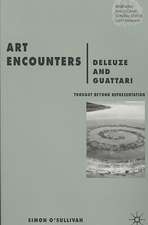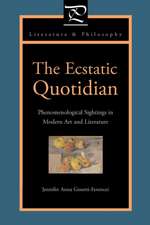Counter-Memorial Aesthetics: Refugee Histories and the Politics of Contemporary Art: Radical Aesthetics-Radical Art
Autor Veronica Telloen Limba Engleză Paperback – 19 oct 2016
| Toate formatele și edițiile | Preț | Express |
|---|---|---|
| Paperback (1) | 179.98 lei 6-8 săpt. | |
| Bloomsbury Publishing – 19 oct 2016 | 179.98 lei 6-8 săpt. | |
| Hardback (1) | 714.27 lei 6-8 săpt. | |
| Bloomsbury Publishing – 19 oct 2016 | 714.27 lei 6-8 săpt. |
Preț: 179.98 lei
Preț vechi: 208.35 lei
-14% Nou
Puncte Express: 270
Preț estimativ în valută:
34.44€ • 36.83$ • 28.71£
34.44€ • 36.83$ • 28.71£
Carte tipărită la comandă
Livrare economică 17 aprilie-01 mai
Preluare comenzi: 021 569.72.76
Specificații
ISBN-13: 9781474252737
ISBN-10: 1474252737
Pagini: 272
Ilustrații: 44 bw illus
Dimensiuni: 138 x 216 x 13 mm
Greutate: 0.41 kg
Editura: Bloomsbury Publishing
Colecția Bloomsbury Academic
Seria Radical Aesthetics-Radical Art
Locul publicării:London, United Kingdom
ISBN-10: 1474252737
Pagini: 272
Ilustrații: 44 bw illus
Dimensiuni: 138 x 216 x 13 mm
Greutate: 0.41 kg
Editura: Bloomsbury Publishing
Colecția Bloomsbury Academic
Seria Radical Aesthetics-Radical Art
Locul publicării:London, United Kingdom
Caracteristici
The movement of refugees and the problematic management of international border restrictions is a highly topical subject with far-reaching relevance to the contemporary political moment
Notă biografică
Verónica Tello is Vice-Chancellor's Postdoctoral Research Fellow at the National Institute for Experimental Arts, UNSW Art & Design, University of New South Wales, Australia.
Cuprins
List of IllustrationsAcknowledgements Prologue: Refugee Flows and Networked Events Introduction 1 Counter-Memorial Aesthetics 2 Arte de Conducta and The Manipulation of Memory: Tania Bruguera's Biopolitical Ambitions in Postwar Cuba 3 Aftermath Photography, Temporal Loops, and the Sublime of Biopolitics: Rosemary Laing's to walk on a sea of salt 4 The Nexus of Self and History: Lyndell Brown and Charles Green's Atlas 5 History Painting, Fiction and Paranoia: Dierk Schmidt's SIEV-X - On a Case of Intensified Refugee Politics 6 Counter-Memorial Aesthetics in an Era of Contemporaneity: Isaac Julien's Ten Thousand Waves, Hito Steyerl's November and other Engagements with Too Much Time Afterword: Living with AftermathNotes Select Bibliography Index
Recenzii
Counter-Memorial Aesthetics is accomplished, moving, fluent and challenging. Tello's command of the pertinent theoretical literature, her sense of the key projects inflecting the potential of hermeneutics to frame the meaning made by and received from a recent tradition of the aesthetic of refugee histories in nations such as Australia, Cuba, the US and the UK, and her keen ability to pinpoint those forms of counter-memory, bare life, and perpetual aftermath immanent, manifest, or implicated in the art projects that provide the structure and thrust for her analysis are all very impressive. This is an inspiring, rigorous, complex and necessary piece of work that makes a real contribution to its fields of inquiry.
Veronica Tello's book constitutes a substantive and original contribution to knowledge within the field of contemporary art history. She takes as her topic a subject central to contemporary experience, and of growing importance within contemporary art: the enforced migration of those who have been displaced from their homes by natural disaster, war, political and ideological struggles, or the impacts of economic globalization, and the complex responses within the polity of advanced societies to such people. Focusing on certain artist's treatments of the latter aspect of the topic, she advances an original argument that these artists are developing what she terms 'counter-memorial aesthetics.' This is an approach that is not only highly relevant to the artistic handling of this particular topic, but is an interesting contribution to what I believe is an emergent paradigm within contemporary art practice and theory more generally.
At a time in which the political discourse on migration moves further and further away from humanitarian perspectives, and entrenches itself in ever narrowing forms of nationalist self interest, it is refreshing to see how new visions of global interconnectedness are being launched by artists. Tello's lucid and original book presents a new paradigm for understanding the relationship between refugee histories and contemporary art. It has an interdisciplinary approach and a global scope that will definitely capture attention.
Veronica Tello's book constitutes a substantive and original contribution to knowledge within the field of contemporary art history. She takes as her topic a subject central to contemporary experience, and of growing importance within contemporary art: the enforced migration of those who have been displaced from their homes by natural disaster, war, political and ideological struggles, or the impacts of economic globalization, and the complex responses within the polity of advanced societies to such people. Focusing on certain artist's treatments of the latter aspect of the topic, she advances an original argument that these artists are developing what she terms 'counter-memorial aesthetics.' This is an approach that is not only highly relevant to the artistic handling of this particular topic, but is an interesting contribution to what I believe is an emergent paradigm within contemporary art practice and theory more generally.
At a time in which the political discourse on migration moves further and further away from humanitarian perspectives, and entrenches itself in ever narrowing forms of nationalist self interest, it is refreshing to see how new visions of global interconnectedness are being launched by artists. Tello's lucid and original book presents a new paradigm for understanding the relationship between refugee histories and contemporary art. It has an interdisciplinary approach and a global scope that will definitely capture attention.
